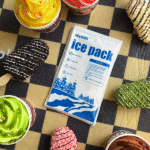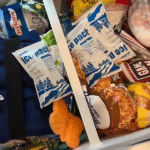Dry Ice Packs for Shipping Perishable Items: 2025 Guide
If you need shipments to arrive frozen and compliant, dry ice packs for shipping perishable items are still the gold standard. Dry ice sits at −78.5 °C and, sized correctly, holds frozen temps for 24–96 hours without meltwater. Use 5–10 lb per 24 hours as your baseline, then adjust for insulation and season. This guide gives you exact math, UN1845 labels, and when to switch to −20 °C PCMs to protect sensitive goods.

-
Right‑size coolant: apply the 5–10 lb/day rule for dry ice packs for shipping perishable items with a simple buffer.
-
Pack and label correctly: UN1845, net kilograms, venting, and acceptance checklists that slash counter rejections.
-
Pick the right tech: when −20 °C PCMs or VIP shippers beat dry ice packs for shipping perishable items on long lanes.
-
Stay current in 2025: USPS ≤ 5 lb rules, IATA acceptance updates, and FSMA 204 timing signals.
How many dry ice packs for shipping perishable items do you need?
Short answer: plan 5–10 lb of dry ice per 24 hours in a well‑insulated shipper; add +20–30% for heat or handling. Blocks extend hold; pellets pull down fast. Mark the net kilograms on the outer carton.
Why it works: Typical sublimation lands near 10 lb/day in common EPS liners. VIP shippers cut that draw and stretch runs to 72–120 hours. Start temp matters: rock‑solid frozen items need less than slushy loads. When lanes are hot or see door‑to‑van hops, increase your margin. Use mixed formats—block as the “battery,” pellets as the “turbo.”
Dry ice packout calculator (frozen payload, quick rule)
Formula:Dry ice (lb) = (Transit days × 5–10) × 1.2–1.3
Choose 5 for VIP/short routes; 10 for EPS in summer. Weigh after packout and write net kg on the box.
| Transit Goal | Baseline (lb/24 h) | Add Buffer | What this means for you |
|---|---|---|---|
| ≤ 24 h | 5–8 | 6–10 | Small EPS/VIP; tape seams and fill voids tight. |
| 48 h | 10–16 | 12–21 | Most food or labs; mix block + pellets. |
| 72–96 h | 18–28 | 22–36 | VIP or thicker EPS; consider PCM hybrid. |
Field‑proven pointers that save pounds
-
Pre‑chill the liner for 10–15 min with a small piece of dry ice.
-
Block at bottom, pellets around/top, payload in the middle.
-
Tight void fill (paper/foam corners) to stop convective leaks.
-
Write net kg clearly—carriers check this at acceptance.
Real case: A bakery shipped 12 frozen pies (~14 kg) in a 22 L EPS with 16 lb block+pellet over a 50‑hour lane in July. Arrival stayed below 0 °F with ~2 lb dry ice left after they pre‑chilled the liner and filled voids—then saved ~3 lb on the next run with a thicker top panel.
How do you pack and label dry ice packs for shipping perishable items?
Do this every time: vent the package, freeze payload solid, layer block → payload → pellets, fill voids, and mark “Dry Ice” or “Carbon Dioxide, solid,” UN 1845, and net kg on the outer face; add Class 9 if required by operator/size. Many air shipments can use the IATA Dry Ice Acceptance Checklist rather than a full Shipper’s Declaration.
Air vs. ground vs. mail:
-
Air cargo (IATA PI 954): mark UN 1845 + net kg; operators may require weight disclosure at booking. Passengers are limited to 2.5 kg in baggage—don’t confuse that with freight.
-
Ground (many UPS lanes): treat like standard parcel but keep all safety/marking best practices.
-
USPS (U.S. domestic air): ≤ 5 lb per mailpiece; international prohibited; packaging must vent.
Labeling checklist (printable sequence)
-
Rigid, insulated shipper (EPS/VIP) that vents CO₂—never airtight.
-
Weigh dry ice after packout; record net kg.
-
Write “Dry Ice” / “Carbon Dioxide, solid,” UN 1845, net kg on a single face.
-
Apply Class 9 label if required by mode/operator.
-
For air, include UN 1845 + net kg on the air waybill and attach the acceptance checklist if used.
When should you choose PCMs over dry ice packs for shipping perishable items?
Use −20 °C PCMs when the payload must stay frozen without ultracold surface shock (e.g., delicate pastries, glazed seafood), or when you want reusable, hazmat‑free handling. Place a thin PCM layer next to the product and dry ice outside it for endurance. Gel packs (0 °C) are best for “cold, not frozen” deliveries.
Hybrid setups that lower risk and weight
-
Frozen food, hot summer: thin −20 °C PCM hugging the payload; dry ice around/top to extend hold.
-
Long 3‑day lane: VIP shipper + thin PCM layer reduces total dry ice and DIM weight.
-
Fragile biologics: PCM around vials to buffer spikes; dry ice in voids.
Vendors offer −23 °C PCMs and families from −40 °C to +37 °C for precise control.
What changed in 2025 for dry ice packs for shipping perishable items?
Acceptance got faster and stricter. Carriers and IATA emphasize checklist‑based acceptance: matching marks (UN 1845, proper name, net kg), correct Class 9 placement, and air waybill entries. USPS limits are unchanged (≤ 5 lb domestic air; international prohibited). In parallel, FDA proposed extending FSMA 204 compliance by ~30 months—use the time to digitalize traceability.
2025 trends for dry ice packs for shipping perishable items
What’s hot now (Updated: August 2025):
-
VIP + −20 °C PCM adoption to extend lanes to ~120 h with less refrigerant mass.
-
Booking‑time net‑kg checks for aircraft CO₂ ventilation planning; weigh precisely.
-
Reusable –96 °C data loggers becoming routine for frozen food, not just pharma.
Snapshot
-
Carrier job aids reduce rejections by standardizing label placement and kilogram marking.
-
Hybrid packouts cut surface freeze damage while lowering ice mass.
-
CO₂ markets stay seasonally tight—dual‑source for Q4 peaks.
Quick “Packout Picker” (interactive checklist you can use)
-
Outcome:
-
Keep frozen hard → start with dry ice packs for shipping perishable items.
-
Keep frozen, avoid surface frost → −20 °C PCM snug to product + dry ice outside.
-
Keep cold, not frozen → 0 °C gel packs.
-
-
Transit time:
-
24 h: 5–8 lb dry ice or 1–2 −20 °C PCM panels
-
48 h: 10–16 lb or 3–4 panels
-
72 h: 18–26 lb or VIP + 4–6 panels
-
96 h: 26–40 lb with VIP or VIP + PCM hybrid
-
FAQ
How many dry ice packs for shipping perishable items do I need for 48 hours?
Plan 10–16 lb, then add 20–30% for season and handling. VIP reduces mass; EPS needs more.
Do I need a Shipper’s Declaration for dry ice?
Often no when used only as a refrigerant with non‑DG cargo, but you must mark UN 1845 + net kg and apply Class 9 as required. Operator variations apply.
Can I mail dry‑ice‑cooled food with USPS?
Yes domestically with ventilation; ≤ 5 lb per air mailpiece. International is prohibited.
Should dry ice go on top or bottom?
Place around and on top so cold sinks over the payload. Fill voids to avoid hot spots.
Summary & next steps
Key takeaways: Dry ice packs for shipping perishable items work best when you vent the box, size 5–10 lb/day with a 20–30% buffer, and mark UN 1845 + net kg. Use blocks for reserve, pellets for pull‑down, and VIP/−20 °C PCMs for long or sensitive lanes.
Action plan (today):
-
Pick coolant (dry ice / −20 °C PCM / gel) by arrival temp.
-
Calculate with the 24/48/72/96 h bands; add buffer.
-
Pack to vent, weigh, and write net kg; apply UN 1845 / Class 9 if required.
-
Attach acceptance checklist and log temps; refine the spec on your next run.
About Tempk
We design validated, lane‑specific packouts across EPS/VIP shippers, dry ice packs for shipping perishable items, and −20 °C PCMs. Our templates pair carrier‑compliant labels with clean SOPs to cut excursions and acceptance delays, backed by –80/–96 °C logger traces for proof. Typical results: longer holds, fewer relabels, and lower DIM weight.
CTA: Share your inside box size, payload weight, and transit hours—get a tested coolant mass, packout diagram, and label checklist you can deploy this week.























